
Press Enter to search

Pros & Cons of Adding an Address To Your Resume: 2024 Resume Tips
Adding an address to your resume can help you in your job search. Here are some tips from a recruiter on what you should and should not include when adding your address.
2 years ago • 9 min read
When it comes to building your resume, there's a lot of information out there on what you should and shouldn't include. To make things even more complicated, a lot of resume advice still being passed around is based on outdated hiring practices. So, how necessary is it to add an address to your resume in 2024?
Should you add your address to your resume?
The short answer is: No, you don't need to add an address to your resume.
In today’s workforce, most communication is done via email or phone, which makes the need for a full address outdated. Instead, you should list a general location on your resume, such as city and state, or city and country.
That being said, there are still some situations when an address might be needed. Such as:
- If location matters for the role : For jobs requiring a local presence or knowledge, listing at least a general location is recommended.
- If you're relocating to a new city : Indicate your planned relocation address if you're applying for jobs in a city you intend to move to.
- When applying to local companies : If the company is known for its traditional approach or strongly prefers local candidates, including your address can be beneficial.
You should leave your address off your resume:
- For remote or global applications : If you're applying for remote work, your physical location is often irrelevant.
- If you're searching for jobs in various locations: If your job search includes various regions or states, including a specific address may limit your opportunities.
- If your address isn't stable : For those who travel frequently or don't have a permanent location, omitting an address can avoid confusion.
If you’re wondering what else, like your address, should be added or left off your resume, upload it to the tool below — it’ll scan your resume and tell you what’s missing and what needs to be included.
Listing an address on your resume: Pros & Cons
There are still some potential benefits to listing an address — or at least a general location — on your resume:
- It’s the workplace standard. If left off, it risks raising red flags . More traditional companies and older hiring managers in particular may expect to see it, so if applying to one of these companies, consider keeping your full address on your resume.
- It’s used by Applicant Tracking Systems (ATS) . ATS filters use the listed location to filter out non-local applicants.
- It affects the company. Even if a job is remote, some companies may still want employees to be available for in-person meetings or events. Different states also have different employment laws, which means companies may only be hiring applicants based in certain regions.
- It shows that you're local. This can be important to employers who are worried about the effects of a long commute, or where local knowledge is a plus.
On the flip side, here's why not to add your address to your resume:
- It’s outdated. Companies no longer need this information to contact you — your email and phone number are sufficient.
- It's unnecessary. This is especially true if you're applying for remote positions. By not including your full address, you now have additional space to add in an extra line or two of information that highlights your skills.
- Location bias. It's unlikely, but a full address creates the possibility for a hiring manager’s potential bias against an area, and can hurt your chances of landing the job. It also helps to leave your location off your resume if you aren't local or want to avoid concerns about a long commute.
- Online privacy. Online privacy is a big deal and should be considered whenever you post your name and address online. Using your full home address on your resume could open you up to identity theft, scammers, unwanted marketing, or spam, especially if your resume is posted to public forums.
- Safety concerns. Once your resume is sent out, you lose control over who can and can’t view it. This goes double for resumes posted publicly on job boards like Indeed, or if the job posting leaves you questioning its authenticity. If it seems sketchy, the last thing you want is your personal information falling into the wrong hands. Here are some tips on finding legitimate job board websites .
How to add your address to your resume
Formatting a resume is almost as important as the information you provide. Here's what you need to know:
- Don't list your full address.
- List your general location — city, state, or geographic region are all fine.
- Include your location in your resume header along with relevant contact information such as phone number, email, and LinkedIn profile.
- If you're planning on relocating , list your location as the city you're moving to.
- If you're working remotely, list your home address or 'Remote.'
- Keep your location updated on LinkedIn – especially if you're currently job searching.
Tips for formatting your address
There are several variations of how you can format your address. Here are a few to help you get started. City, state. This is the most common way of formatting an address on your resume.
San Francisco, CA
City, country. This format is also fine, especially if you're applying for jobs outside the United States.
Wilmington, USA
Geographic region. For jobs in the United States, you can place your general geographic region. This is less standard but works just fine.
Chicagoland Area
Zip Code or full address. The workforce might be trending away from this, but it is still perfectly normal to include it.
555 Main Street, Anywhere, AR 00000
How to list your address if you're relocating
When applying for jobs in a city you plan to relocate to, always include that city as your address. This prevents ATS filters from flagging your resume for not having a local address.
Option 1: Mention that you're relocating and include an expected timeframe.
Relocating to Chicago, IL in Spring 2024
Option 2: List your location as the city you're moving to without mentioning where you currently live.
Chicago, IL
If you frequently move, it’s best to choose a long-term address, such as a family home or a P.O. box, to maintain consistency in your applications. Listing a general location, such as a city or state, is also easier for frequent movers, as it can be updated less often.
How to list your address if you work remotely
Whether you need to list your location when you're working remotely will vary according to the company. If you're not sure, check the job listing — if a location is specified, or if there's a list of locations where employees should be based, always include your address.
To include your address: List the location where you live or are mostly based (your residential home for tax purposes).
New York, NY
To omit your address: If you travel a lot or otherwise prefer to leave your address off your resume, list 'Remote' along with your time zone.
Remote (ET time zone)
How to list your address if you're applying internationally
For international job applications, it's essential to format your address in a way that is clear and understandable to employers in the country you're applying to. General locations are far more relevant than full street addresses.
Option 1: List your general area, including city and country.
Vancouver, Canada
Option 2: If your local town is small, choose the closest large city or your state/province.
Option 3: You can also simply list your country and time zone.
Canada, PST Time Zone
What other information to include in your resume header
Along with your address, there are a few other pieces of information you should include in your resume header .Let’s break down what to include, what is optional, what you should leave off.
Here's what to include :
- Phone Number
- Email Address
These items are aimed at providing prospective employers with the best ways to contact you.
Here's what you can include, but don't have to :
- LinkedIn Profile
- Portfolio Or Professional Website
While not necessary, these items allow prospective employers an additional look at any skills you might bring to the table.
Here's what to leave off:
- Full Street Address
- Personal Details– birth date, marital status, gender
- Social Media Links– Twitter, Facebook
- Multiple Phone Numbers Or Email Addresses
These items open the door to possible discrimination. In the case of multiple phone numbers or email addresses, it might cause confusion as to which is the best way to contact you.
How to list your location on LinkedIn
In the current job market, job seekers can expect to find more opportunities for remote work and job leads from LinkedIn. Keep the previous information in mind when searching for these roles or updating your LinkedIn profile .
Use the LinkedIn Optimization tool to ensure your location is up to date on the platform.
Alternatives to listing your street address on your resume
Some industries or applications might still require a street address on your resume. In that case, here are some creative alternatives to listing your actual home address to balance the need for a geographical location with concerns for privacy and security.
- A P.O. Box: A post office box provides a physical address for employers without revealing your home location.
- Professional mailbox services: These services provide an actual street address, which can look more professional than a P.O. Box.
- A virtual mailbox: These services offer a physical address where your mail is sent before being scanned and sent to you online. Ideal for remote workers or frequent movers.
- Co-working spaces: If you regularly use a co-working space, it can serve as a professional and stable mailing address.
- Address of a trusted contact: For those currently moving or planning to move soon, using a trusted friend or family member's address can work as a replacement for your address, until you're settled.
The relevance of including a physical address in different industries and roles
The importance of including a physical address on your resume will vary depending on your industry, your level, and the nature of your work. Generally, roles that require face-to-face client interaction are more likely to require a physical address than those that don't.
For entry-level applicants, including a physical address is less critical, especially if applying for remote positions. Mid to high-level candidates often have more established professional networks and specific location-based expertise. Including a physical address can, therefore, be helpful for these high-level roles.
Here's a breakdown of different industries and how relevant physical location tends to be for your application:
Freelancers and remote workers
Relevance : Low
Freelancers and remote workers often work for multiple clients in various locations, making the applicant's physical location less relevant. Omitting your address or listing 'Remote' is generally more appropriate, and instead, include your timezone on your resume to help with employer correspondence.
Creative industries: Art, design, media
Relevance : Low to moderate
Many creative roles are project-based and can be done remotely. Consider omitting your address unless applying for a position that requires physical presence, like in-studio work.
Tech Industry
Relevance : Varies
While many tech jobs offer remote work, some roles, especially at startups or companies with a strong in-office culture, might value local candidates. Research the company culture and job requirements to determine if a street address is needed.
Sales and marketing
Relevance : Moderate, depending on the role.
Local sales roles, especially those requiring face-to-face client interactions, benefit from a local address. For digital marketing, location is less relevant. Include a city location for local positions, and a more location for global or digital marketing roles.
Financial and banking
Relevance : Moderate to high.
While many financial roles include remote work, those involving direct client interaction or specific market sectors may require a local candidate. Tailor your resume based on the particular role, including a local address for client-facing or market-specific positions.
Legal and consulting services
Relevance : High for legal, moderate for consulting.
Legal professionals often need to be licensed in their specific state or region. Consultants, while sometimes able to work remotely, may need to travel to client sites. Lawyers should include their local address, while consultants can tailor based on the nature of the consultancy and client needs.
Real estate, retail and hospitality
Relevance : High
These industries often require local knowledge or on-site presence. Including at least a city is often required for these industries.
Healthcare and education
These fields often require workers to be on-site. Including your local address can be beneficial, particularly for public-facing roles.
Manufacturing and logistics
These industries often require on-site work and proximity to logistical hubs. Include a local address, especially for roles that involve direct operations or management of physical goods.
Key takeaways
In today’s workforce, including your full address on your resume is no longer necessary. However, including a general location on your resume provides an added boost to your job search.
To further enhance your resume, check out the free tool, Score My Resume, which scans your resume and provides feedback on how to improve it.
Spread the word
How many jobs should you apply for in 2024 a breakdown., what file format should you use for your resume, keep reading, how to show bilingualism on your resume (with examples), oops what to do if there’s a mistake on your resume, getting the basics right: resume line spacing, subscribe to our newsletter.
Stay updated with Resume Worded by signing up for our newsletter.
🎉 Awesome! Now check your inbox and click the link to confirm your subscription.
Please enter a valid email address
Oops! There was an error sending the email, please try later

Thank you for the checklist! I realized I was making so many mistakes on my resume that I've now fixed. I'm much more confident in my resume now.


How to List Address on a Resume in 2024 – Format, Pro Tips & Examples
In This Guide:
What is the right way to add an address to your resume
What are the advantages of including an address on your resume
What are the disadvantages of including an address on your resume
When is it mandatory to put a physical address on your resume
Are there alternatives to providing your home address on a resume
What to put on your resume if you are relocating
What others did to get hired
Bottom line.

So you're ready to start applying for your next job. But you're not sure about the correct format to use for the address on your resume. Or you may even wonder if you should include one in the first place.
To make you feel better, these are common questions that applicants ask during their job hunt. Besides, even HR experts have contrasting opinions about physical addresses on resumes.
Today's guide will provide a thorough explanation of how to put your address on a resume. We'll also go over the pros and cons of revealing your location and how that may affect your job search success.
Let's get started.
The short answer
To include an address on your resume, place it in the header or contact information section at the top , using a consistent format. Consider privacy concerns and whether to include only your city and state.
Ensure the address aligns with your resume's overall design and if you think it's relevant, use an address local to the company (for example, if you're relocating for the job in question).
What is the right way to add an address to your resume?
Upload & check your resume.
Drop your resume here or choose a file . PDF & DOCX only. Max 2MB file size.
First things first, you must know where the address should come on the page before you think about how to write it. This is important because each section in your resume has to showcase specific details about you.
In the case of your address of residence, it should always be featured in the resume header . This makes it easier for recruiters to find your location with the rest of your contact details.
There have been major developments in how resumes are written over the past few decades. You can clearly see that difference if you take a closer look at how addresses on resumes are formatted today.
With the current trends, job applicants are no longer required to include their full physical addresses. That's simply due to how easier it is for employers to reach out to applicants online throughout the hiring process.
So if you're applying for a job in the U.S. or Canada, you only have to include the city and state you live in. This format is best because it keeps your contact details safe while giving the employer the information they need.
Your address should look something like this:
- New York City, NY
- Anjou, Montreal
- Chicago, IL
In other parts of the world, you may be required to add a more precise location. For example, it's common for job seekers in Europe to put their complete addresses including the street and Zip code. The reason for that are their strict GDPR laws that keep safe personal information like resumes.
Recommended reads
Perfecting Your Resume Header so You Get Noticed
What are the advantages of including an address on your resume?
Prove that you live nearby.
Long commutes to work every day will have a negative toll on any employee, no matter how motivated they are at the start. It can also be a cause of a lot of absenteeism and a lack of overall productivity.
Because of that, recruiters hiring for on-site positions are concerned about the location of their applicants. In fact, this is one of the biggest reasons why addresses are still required to this day.
A hiring company can ask for specific locations in the job description. By showing that you live nearby the area, you'll put yourself ahead of most applicants that don't feature an address.
Leave a pleasant impression with an in-person interview
Being a local applicant grants you a major advantage when it comes to making a strong lasting impression. While virtual meetings were on the rise during the pandemic, more and more companies are going back to physical interviews to hire candidates.
When you meet the recruiter in person for an interview, you'll be able to establish trust quickly and move to the more important stuff. You'll also have the chance to showcase your best personality traits and interpersonal skills.
Make yourself easily reachable
By providing the correct address on your resume, you'll make it easy for recruiters to reach out to you. This is especially true in many parts of the world where sending documents via physical mail is still a common practice.
Get past applicant tracking systems (ATS)
A correct address on your resume won't only make you look good to recruiters, but also to applicant tracking systems (ATS).
An ATS is a tool that companies use to filter through long lists of candidates quickly and identify the best ones from the pack. It relies on keywords to scan resume pages and find applicants that meet all the requirements.
So by including the required location in the header, you can easily get past the automated screening phase. That can help you land a lot more interviews and increase your job success rate significantly.
What are the disadvantages of including an address on your resume?
You'll become an easy target for discrimination.
By the end of the day, recruiters are only human and can make bad decisions. They're likely to fall for certain biases without even knowing them when selecting candidates for a job.
One example of how that may happen is discrimination based on location. Perhaps the hiring manager has had a few negative experiences with applicants from your area. Or maybe they just have incorrect prejudgments about your neighborhood or city.
Even if unintended, discrimination is still a current problem in the hiring industry. That's why job searchers often have to think twice before putting an address on their resumes.
You'll limit your job search to certain geographical locations
You can think about this as a glass that's both half empty and half full. Putting an address on your resume does have its own benefits when you live close by. But it can also be a cause for rejection whenever applying for jobs that require a long daily commute.
Unless hiring for a remote position, companies usually pay close attention to the location of the candidates. This allows them to minimize relocation costs and guarantee that their employees won't miss any work days.
You'll find it difficult to keep your personal life private
The biggest concern for job applicants who put an address on their resumes is privacy.
The thought of having your contact details plus your location available online can be stressful. When you upload your resume to a job board, you never know who's on the other end to read it. So you need to be careful about sabotaging your own privacy.
Keeping your personal and professional lives separate should always be a priority. But when you add an address to your resume, you're basically putting it online for anyone to see. There are many instances when keeping your home address private may be necessary.
When is it mandatory to put a physical address on your resume?
To be honest, highlighting your location on a resume does have its pitfalls. But despite those disadvantages, showing your address can sometimes be the only way to get shortlisted and hired for the job.
Here are four situations where your contact details must include a correct address:
If the hiring company is concerned about relocation costs
Companies have their own struggles when it comes to hiring quality candidates. And one of their primary concerns is how much they're going to invest in a new employee that's far from their location.
The truth is, you'll probably struggle to make it past the screening phase if you use your real address in this case. However, many companies are open to hiring experienced applicants who are open to relocating. Even better, some organizations may offer you a relocation package when they see how valuable you can be to their business.
To show that you're willing to relocate, you need to add a note next to your address in the header. You may also mention that in the cover letter to explain how and when you'll be relocating.
How do you know if the company is concerned about relocation?
Start by reading the job offer, and you'll find that mentioned somewhere, usually under requirements.
Another way to get informed about the employer's hiring policies is to look that up online if the business is popular. Or you can ask current employees and try to learn more from past experiences to see whether relocating can be a solution.
If the job offer asks for specific locations
If your job requires your physical presence, hiring companies will expect you to live in nearby areas. That's how they can ensure you'll miss minimal days at work and that you'll always have the energy to excel at the position.
The hiring manager may write something like “must live in X, Y, or Z.”
For positions like this, the job offer will emphasize how important it is to reside in specific locations. But even if it doesn't, it's mandatory for you to include a physical address if you want to gain an advantage over the rest of the applicants.
Keep in mind
If the job you're specifically applying for specifically asks for an address you should list no more than a single address on your resume. And it has to match the company’s location. Even if you want to be thorough in your resume, putting two addresses in the header will only confuse recruiters.
If you're applying for a government job
For government jobs, the home address is a crucial part of your contact details — along with your email and phone number. In fact, some federal positions may even require you to include a permanent address including your street name.
The good news is, you don't have to worry much about your privacy since the government isn't a private party. So you can create a separate resume and use it only for federal job offers.
If your job involves working with the public
Despite the rise of remote jobs and work-from-home positions, the majority of occupations today still require physical presence. That includes jobs in public service such as firefighters, law enforcement officers, social workers, public school teachers, etc.
When hiring for these positions, companies will want to know your location to guarantee culture fit and your knowledge of the area. For example, post offices prefer hiring local drivers who know the ins and outs of each street in the city.
Are there alternatives to providing your home address on a resume?
The truth is that if you play your cards right, you can land any job you’re qualified for. And that's despite the address you use or whether you put one in the first place. There are a few solutions for job seekers to keep their information safe and make recruiters happy.
Here are three easy ways to get away with not putting a home address on your resume:
List a generic physical address
It's important to keep in mind that recruiters no longer use physical addresses to reach out to applicants. The primary reason a company may want to know your location is to assess proximity.
So a simple alternative here would be to provide a nonspecific address to serve as a point of reference. In other words, you'll inform the hiring organization that you live in the vicinity — but without giving them your exact location.
You can use the address format we shared with you in the examples above, which is "City, State."
If you intend on applying for jobs overseas, listing just your country can be enough to make it past the initial screening phase.
Use a temporary P.O. box
The truth of the matter is, some organizations may still use the physical address to contact applicants. This is especially true in traditional industries or countries that are still behind technologically.
The solution? Put a temporary P.O. box as your resume address so you can receive important documents in the mail. You can easily get one at your local office for a low cost and use it as your home address throughout your job hunt.
Include a LinkedIn profile URL
Featuring a LinkedIn URL in the header is a must — even if you're not worried about your address. It's an excellent way to showcase skills and recent accomplishments while keeping your resume short.
But despite those obvious benefits, this practice can grant you another advantage when it comes to contact details. LinkedIn is an ideal solution if you're moving a lot while hunting for jobs in different locations. While you can update PDF or physical resumes in real-time, your online profile can keep all recruiters updated with your current location.
Your online profiles on social media can have a huge impact on your job application — especially in the final stages. Take a few minutes of your time to check out the recruiter check quiz on our platform. It’s a quick survey that will help you make your online presence appealing to all recruiters.
What to put on your resume if you are relocating?
The address in your resume is expected to show your current location of residence. And that's despite the format you use or where you'll put the address. So unless you give recruiters a clear hint, they're all going to assume that you're not open to relocating.
To show that you’re moving to a new city or state, you can simply add “Relocating to” before your address. For example, if you’re moving to New Jersey for the new job, you can write “Relocating to Newark, NJ.”
Case study: Ramsey's product manager resume

When applying for his dream job at American Express, Ramsey used a semi-general location in his resume header. This allowed him to inform recruiters that he lives nearby the area and can always make it to work on time.
The best part is that Ramsey didn't have to reveal any sensitive information about where he lives. This format ensures the perfect balance between generic and informative.
Further reading
- Product Manager Resume
Case study: Mia’s research assistant resume

In her application for postdoctoral research, Mia included the address of her research department at the University of York. Because there was no requirement for her home address, she didn't have to give away her own privacy. The final result? Mia got accepted for the position and is taking advantage of further opportunities.
- Research Assistant Resume
Case study: Adam's IT resume

Because the job offer required applicants to live in Derbyshire, Adam had to add a location to his IT sales resume. But since he used a generic address format, he was still able to meet the requirements without having to deal with privacy concerns.
Featuring the home address on resumes has always been a gray area among job search experts. There are many cases where showing your current location is a must for getting hired. But on the flip side, your address is a sensitive piece of data that should be kept private.
As a rule of thumb, you should only add one address to your resume. The best format for that is to include your city and state like the examples shown above.
If you're relocating, be sure to give hints about that in the header, the cover letter, and even the interview. This will help you demonstrate to recruiters that you're a perfect match for their ideal candidate requirements.

- Resume Guides
12 Great Jobs for Stay at Home Parents
Can i handwrite my resume, what to bring to an interview: fail-proof your interview with these 10 useful items, dates on resume: how to format, templates & tips, how to answer the "what is your 30-60-90-day plan" interview question, the different ways of submitting a resume.
- Create Resume
- Terms of Service
- Privacy Policy
- Cookie Preferences
- Resume Examples
- Resume Templates
- AI Resume Builder
- Resume Summary Generator
- Resume Formats
- Resume Checker
- Resume Skills
- How to Write a Resume
- Modern Resume Templates
- Simple Resume Templates
- Cover Letter Builder
- Cover Letter Examples
- Cover Letter Templates
- Cover Letter Formats
- How to Write a Cover Letter
- Cover Letter Guides
- Job Interview Guides
- Job Interview Questions
- Career Resources
- Meet our customers
- Career resources
- English (UK)
- French (FR)
- German (DE)
- Spanish (ES)
- Swedish (SE)
© 2024 . All rights reserved.
Made with love by people who care.
Protect your data
This site uses cookies and related technologies for site operation, and analytics as described in our Privacy Policy . You may choose to consent to our use of these technologies, reject non-essential technologies, or further manage your preferences.
- Resume and Cover Letter
- Ask Amanda: How Should I...
Ask Amanda: How Should I Format My Contact Information on a Resume?
6 min read · Updated on March 21, 2024
.jpg)
When hiring managers want to reach out to you, help them know where to look.
Q: How should I write my name, address, and social media on my resume?
Is there a right way to add your name and address on a resume? And if so, how should I format them? – Tamara D.
When you're writing a resume , it's important to include all of your pertinent contact information at the top so employers and recruiters can easily locate it. While this resume tip may seem obvious, a TopResume study found that one in four people either forget to include all of the necessary details or fail to format them in a way that can be detected by the software employers use to organize and manage their inbound applications.
Below is everything you need to know about including contact information on a resume and formatting it for success.
What to include in your resume contact information section
Include your first and last name on your resume. If you have a very common name – think “James Smith” or “Maria Garcia” – consider including your middle name or middle initial to help distinguish you from the other 30,000+ professionals who share your full name.
Preferred Name: If you typically use a preferred name at work, it's perfectly acceptable to list that name instead of your legal name on your resume. For instance, some professionals continue to use their maiden name at work after they've married and legally changed their last name to that of their spouse. Others prefer to go by a nickname for their first name to avoid gender bias or racial discrimination during the job search.
Examples: How to Write Your Name on Your Resume
Maeve (Nelson) Hunter | Maeve Nelson | Maeve Hunter
William H. Keener, Jr. | Bill Keener, Jr. | William Keener
Allie Bostwick | Allison (Allie) Bostwick | Allison Bostwick
S. Schaffer | Sam Schaffer | Samantha Schaffer
Khalid “Kal” Hassan | Khalid Hassan | Kal Hassan
Credentials as Suffixes: If you have earned an advanced degree or certification that is required for or considered desirable in your field, be sure to include its initials after your name. By mentioning this credential at the top of your resume and elaborating on its details further down in the document, you're increasing the chances that recruiters will notice this important selling point during their initial, cursory review of your job application. For example:
Joshua Eggleston, RN
Avery Thiele, PMP, SSGB
Jesse Warch, MBA
However you decide to write your name on your resume, be consistent. Your name should be represented the same way on your business cards, cover letters, email signature, relevant social media channels, blog or portfolio, and so forth.
Mailing Address
I've been asked numerous times how to write an address on a resume, but the truth is that it's no longer necessary to include your full mailing address. These days, many job seekers avoid adding all of this contact information because of concerns over identity theft or personal security, while others want to use that valuable resume space for other details that promote their qualifications.
If you're looking for a job within a commutable distance from your home, include your city, state, and zip code on your resume. If you're conducting a long-distance job search or you're open to relocation, you may opt to not include any mailing address information at all.
Related: The Essential Parts of a Resume, Explained
Email Address
If you're still using an old AOL or Hotmail address to manage your email, it's time for an upgrade . Create a new, professional-looking email address for all your job-search activities with a modern provider like Gmail. Where possible, incorporate your name or your specialty into your email address, such as “[email protected]” or “[email protected].”
Phone Number
Never use your work phone number on your resume –– that's the quickest way to make your confidential job search not-so-confidential. Instead, include your personal cell phone number. That way, you have control over the voicemail message, who answers the phone, and when it is answered. When setting up your voicemail, be sure to include your name in the message so employers know they have called the right person.
When it comes to listing your phone number on your resume, there are a number of different formats that are considered acceptable:
555-867-5309 | (555) 867-5309 | 555.867.5309
You can also choose to put a label in front of your phone number such as “Tel:”, “Ph:”, “Phone:”, “C:”, or “M:” (for mobile).
Social Media
Including social media on a resume has become commonplace. In fact, studies show that most recruiters will search for your online profiles before deciding whether to interview you. By including the most relevant social media links on your resume, you're saving recruiters time and providing them with the details they care about. Start by adding the link to your public LinkedIn profile . Other social media accounts should only be mentioned on your resume if they're related to your profession. If you work in a creative field, for example, consider adding a link to your online portfolio or blog as well. Whichever links you decide to include on your resume, be sure that they will support, rather than sabotage, your job-search efforts and that they are kept up to date.
How to format your resume contact information
Place your contact information at the very top of your resume so recruiters can't miss it. If you're using Word, be sure to not place these important details in the header section of the document, as not all applicant tracking systems are able to properly read and parse information stored in this section of a Word document.
Place your name at the top of this section, using a larger font size than the other pieces of contact information so that it stands out. Depending on how much space you have to work with, you can place the rest of your contact details in one or two lines, located just below your name. Below are a few examples of how you can format the contact information on your resume.
Resume Contact Information, Example 1:
Resume Contact Information, Example 2:
Resume Contact Information, Example 3:
Click on the following link to view all of our resume samples and see the many ways you can format your name and address on a resume.
Need help formatting your resume for success? TopResume's expert writers can help .
Amanda Augustine is a certified professional career coach (CPCC) and resume writer (CPRW) and the resident career expert for Talent Inc.'s suite of brands: TopResume , TopCV , and TopInterview . On a regular basis, she answers user questions like the one above. Have a question? Take a look at her career advice or ask a question on her Quora page .
Recommended Reading:
Here's the Right Way to Format Your Resume
Ask Amanda: How Do I Format Multiple Locations for One Employer?
Why You Shouldn't Write Your Own Resume
Related Articles:
Do Hiring Managers Actually Read Cover Letters?
How to Create a Resume With No Education
From Bland to Beautiful: How We Made This Professional's Resume Shine
See how your resume stacks up.
Career Advice Newsletter
Our experts gather the best career & resume tips weekly. Delivered weekly, always free.
Thanks! Career advice is on its way.
Share this article:
Let's stay in touch.
Subscribe today to get job tips and career advice that will come in handy.
Your information is secure. Please read our privacy policy for more information.
When to Include a Resume Address with Examples
Quick Navigation:
What to include in a resume address
Why you should include an address on your resume.
- When to include an address on your resume
Resume address template
Technology has brought about significant changes in the job search process. Rather than using your full address, recruiters only require an email address and telephone number for the basic contact information. Particularly, hiring managers place more emphasis on your skills and experiences than ever before.
However, with shifting trends in resume writing, debating on whether to include an address on your resume can be challenging. For instance, in a case where an employer wishes to hire local candidates, writing your address is essential for viability and local tax incentive purposes. Since creating a top-notch resume is important, this article will help you understand when to include a resume address.
There are many ways to present contact information in a resume.
Here are the basic components for including an address in your resume:
Your full name
Your current/permanent address, your phone number, your email address.
- A link to your social media or LinkedIn account
Your name is your identity and is therefore necessary in your resume address. It should be your full searchable and legal name (middle name optional). Note, if you just got married, you may still need to use the name in your social media accounts or the one that you are commonly known by in your industry.
A quick formatting tip:
The font you use on your name should stand out from the rest of the content. Hiring managers spend limited time reviewing resumes and it is important for them to know who they are reading about.
Generally, use your current and permanent address. Unfortunately, sometimes your address can work against you when seeking a job that is not within your state. In this regard, you might want to exclude your city and state from the address so that the hiring manager can know you are open to relocation.
Alternatively, you can simply write ‘open to relocation’ on your address.
For example:
Xavier Polch
Open to Relocate Nationwide|555-727-8128|[email protected]
The phone number you list on your resume should be your most commonly used number. Be sure to leave the voicemail box open and available to receive messages. Also, include a professional and direct outgoing message.
Other than a telephone number, an email address is the second most useful contact information on your resume. Your email address should be professional and easy to read. It is most preferable to use your first and last name to create a professional email address.
A good example is: [email protected]
A link to your social media or LinkedIn account
Social media affiliation is becoming a trend in the job industry. Many recruiters are now seeking out social media accounts. Update your LinkedIn profile to include your recent employment positions and academic achievements.
An address with your LinkedIn information may look like:
Jonathan Ballard
1973 Sunset Boulevard | Anaheim, California 92801|[email protected]|790-654-2345
www.linkedin.com/ln/jonathanballard
You can include your address on your resume for these reasons:
For easy location of your resume on databases
Most companies allow candidates to sign up for job positions depending on location such as within a certain mile radius. Failure to include your address in such scenarios may cause you to miss these opportunities.
To be straightforward about your location
Some recruiters maintain strict specifications regarding candidates from long distances. You can increase your chances at a job by indicating your location in your personal information.
To show that you are honest with the information you have provided
Since an address is the next closest thing to identifying a person, providing it willingly shows you have nothing to hide. Including your address in your resume may give you a competing advantage over other candidates without addresses.
To clarify your current location
If you have changed locations due to holding different jobs, listing your address clears up any confusion on your current location.
To allow employers to conduct a background check on you
Some employers like to ensure they have the best of the best as their employees. For this reason, they perform background checks on their potential employees. Providing your address makes their job easier and increases your chances of landing a new job.
When to include an address on a resume
You can consider including your address on a resume in these cases:
When applying for a job in another city or state
Indicating your address on a resume allows recruiters to know if you reside in the area and you can easily commute for in-person interviews. It also informs them whether you can start working immediately or that you may require extra time or the expense of relocating.
When relocating to another town
If you are considering moving to another city but are making applications for positions prior to moving, ensure you include your new address on your resume. A good tip would be to include your old address on one line and your new address on another. You should also note this information in your cover letter.
Here is an example:
Beatrice Rhymes
555-787-6789 [email protected] Boston, Massachusetts
Relocating to New York, NY in October 2019
By applying before you relocate and indicating that in your resume, it shows a level of commitment that a potential employer may find appealing.
When applying for a job in your local state or city
In this scenario, include only your current city and state. It allows recruiters to know that you currently reside in that state. There may be instances where an employer sets boundary parameters for concerns of long commutes and local tax incentives.
If you decide to include your address, here are a few ways to include it:

Complete address
898 Grandway St.
St. Louis, MO 63830
City, State:
Boston, Massachusetts
Area or region:
New York | Manhattan
Relocating:
Relocating to St. Louis, MO
Your resume address offers only a few lines but displays important information regarding your identity and professionalism. Ensure the information you list in your address is correct and easy to read.
- Knowledge Base
- Free Resume Templates
- Resume Builder
- Resume Examples
- Free Resume Review
Click here to directly go to the complete resume sample.
It may seem simple, but what all details to add to your resume contact information is a controversial topic.
Some recruiters prefer to see the address on their resume. Some recruiters are fine with the current location on their resumes.
If you want to get out of this confusion, experts at Hiration have figured out a way to resolve all your queries.
In this article, you will learn:
- What contact information should be on a resume?
- Examples of contact details on resume?
- How to include address on resume?
- What things to avoid when writing contact information on resume?
We'll end this with an email address example along with a few samples on how to include address on resume and contact information on resume in general.
What is the most important section on a resume?
Some would say the Professional Summary. Others would side with the actual Professional Experience section.
It’s the resume contact information section!
Think about it: You got all the required key skills. You have the most detailed work section. But you miss-spelled your name. What will happen? The recruiters would not be able to reach you. And you will lose the opportunity.
Do not worry! We have got you covered.
Resume contact information is the data you provide to help the recruiters get in touch with you . That includes the address on resume, your name, email address, and phone number.
In this blog, we will show you how to write contact information on resume . Read on to know how to write an address on a resume.
What Contact Information Should be on a Resume?
On your resume contact information section, you should definitely include:
- Your full name
- Location in City, State format
- Zipcode (if asked by the recruiter)
- Phone number
- Email address
Full Name on Resume
Firstly, do not write “Resume” or “CV” as the heading of your resume. Use your full name.
And ensure your name is consistent across all job application documents.
For example, if you are writing your middle name on your resume, ensure it’s the same everywhere. Similarly, if you are not using a middle name, make sure to omit it from every document related to your job application.
If you mention your middle name, don’t write it in full; instead, use the initials—Seldon L. Cooper, instead of Sheldon Lee Cooper.
Address on Resume
We don’t recommend writing your address on resume unless the recruiter asks explicitly.
There are some solid reasons for doing so.
On a one-page resume, space is the most valuable asset. And if you add your entire address, it eats up unnecessary space. A mailing address is not necessary these days, Everything happens online.
Sometimes, if your mailing address is far from the company location, recruiters may hire a candidate near the company location.
It cuts both ways; Company doesn’t want to hire someone who has to travel a lot to come to the office every day, get burned out, and leave the job.
However, there are some serious reasons for which you should not add your mailing address in resume:
Email Address on Resume
You should use a professional-looking email address. However, don’t use your email address given by your current employer.
Use your first and last name in the email address. Avoid unprofessional email addresses, like coolamanda@gmail[dot]com . Check the email account frequently so that you do not miss out on employer inquiries. Respond promptly.
Phone Number on Resume
A critical rule of phones would be: It is essential to have voice mail. Using voice mail on your phone is helpful. It enables hiring managers to leave a message when you are not available. It helps you not to miss any important calls.
But, be sure that your voice mail message sounds professional. A professional voicemail would be: Hey, it's Alice here. Please leave a message.
Before we move on to the next section on how to include address on resume contact information , we would like to tell you some hacks :
If you have a LinkedIn page or a personal website, include these links in your contact section as well.
For an increased impact, you should try to include your online portfolio. It shows your creativity and dedication towards proving yourself.
Resume Contact Information Examples
Contact Information Resume: 2-Column Resume

Contact Information Resume: 1-Column Resume

Also Read : How to create resume sections?
How to Include Resume Contact Information?
What you choose to display on your resume makes or breaks your entire job prospect. So what should you include to improve your chances? What are the odds?
It begins with your name and other contact information.
We have already discussed what information should be included in your resume contact information. Your name, address, phone number, and email address should always appear at the top of your resume. It does not matter which resume format you are using.
Before we begin, we would like to ask you something.
Did you know that some employers use the contact information section to filter candidates?
They are most likely to give you a pass if you live in another part of the country. This is done to avoid paying relocation costs.
They may form a negative opinion of you if your contact information is inappropriate in some way.
Many recruiters use this information to search for your popular opinion on popular social networking sites. They like to see what is posted about you.
This makes the resume contact information section even more important. What should you include to make sure your resume gets forwarded?
Your First & Last Name
- Your middle name is optional. Include it if you want to distinguish yourself from other job candidates.
- You can use your given first name or your shortened first name. However, it is not advisable to use a nickname. It leads to the formation of opinions.
- Your name should be at the top. It should be able to stand out. You can make your name larger than the rest of the fonts. Or bold your name. Or both. You can center your contact details or align them to the right.
- Leave a space or horizontal line between the end of your contact information and the next section of your resume.
Your Contact Number
- Your home and cell phone numbers can be listed. You can include more than one number.
- Make sure that the numbers you include are active to take calls on.
- Your work phone number is not a good choice. Your employer may/may not allow personal calls. Also, you may not want your current company to know about your job switching.
- Make sure you have a decent voice mail message in case you are prone to miss calls.
- Check your messages regularly. We can recall countless clients who missed a job opportunity just because they were not available on call or couldn't reply to a message/mail.
Your Mailing address or Current/Preferred Location
We recommend candidates not include their mailing addresses on resumes. However, if the recruiters ask for it, then here are some tips to keep in mind:
- Include your full mailing address (street address, city, state, and zip code) instead of just the city and the state.
- In case you have privacy concerns, it's perfectly alright if you do not include address on resume; instead, just write the city/state.
- Use the complete state name if the abbreviations are easily confused with another.
Your Email Address
- Use a conventional email address like: firstname_lastname@email[dot]com.
- Do not use inappropriate emails like pinkpanther@email[dot]com.
- You will need to check your email regularly. Do not miss an opportunity. Make sure your email settings don't automatically send promising emails to the spam folder.
- If you don't have an email account...well, have you been living under a rock this whole time? Make one now!
External Links
You can provide links to a professional online profile or personal webpage only if you think it'll bolster your overall profile. Providing a link to a LinkedIn profile that was updated many months ago will not benefit anyone.
Whatever you include, do remember that it's going to count. You can skip this if you think there's the slightest chance that it might backfire.
You can include links to articles or papers that have been published or other such distinctions.
Also Read: How to choose the correct resume format?
What to Avoid When Adding Contact Information on Resume?
Avoid Typos : A typo is more common than you think. It could prevent you from getting contacted for the job.
Avoid Different Names : Consistency is the key. Avoid using different names in different documents.
Avoid Using Unprofessional Email ID : Do not use a current work email address. Do not use a casual or silly email address. Use a provider that makes you look savvy and professional.
Don’t Use Someone Else’s Phone Number : Avoid providing someone else's phone number. Make sure the phone number you are providing is active. Add a country and area code. Check your voicemail message. Do not personalize your caller tone.
Social Media Handles : Make your social media profiles professional before including social media URLs. However, it’s always a good idea to have an updated LinkedIn profile URL.
Date of Birth : It is not mandatory to include the date of birth in the resume. But it is a quick way to show the employer you are legal for specific jobs.
HIRATION PROTIP: In the US, for instance, it's forbidden to add personal details like age, sex, date of birth, etc., to avoid bias in the shortlisting process. On the flip side, countries in the Mideast, for instance, also ask for passport details. Check the norms for your country or industry before you include these details.
Resume Sample
- Identified web-based user interactions and developed highly-responsive user interface components via React concepts
- Translated designs & wireframes into high-quality code and wrote application interface code via JavaScript following React.js workflows
- Troubleshot interface software and debugged application codes to improve functionality and performance by 50%
- Developed and implemented front-end architecture to support user interface concepts with 100% accuracy
- Monitored and improved front-end performance by 15% and documented application changes & worked on updates
- Developed the latest user-facing features using React.js and built reusable components & front-end libraries for future use
- Optimized components for maximum performance across a vast array of web-capable devices and browsers
- Coordinated with the development team of 35 to discuss user interface ideas and applications
- Reviewed application requirements and interface designs to ensure compatibility with existing applications
- Determined the structure and design of web pages based on user requirements and balanced functional & aesthetic designs
- Created features to enhance the user experience while ensuring that the web design is optimized for smartphones
- Employed a variety of languages such as HTML and CSS to write & create user-friendly web pages
- Built reusable code for future use and optimized web pages for 5 applications for maximum speed and scalability
- Managed brand consistency throughout the design and maintained & improved the company's website by adding more features and functionality
- Liaised with cross-functional teams to ensure that the client projects were completed on time and within a stipulated budget
- Produced high-quality mockups & designed different prototypes and provided high-quality graphics & visual elements
- React Certification (Full Stack Web Development) | Coursera | Dec '17
- Top 20 percentile of the class
- UI Designing
- Application Designing
- Wireframe & Design
- Translation
- Front-end Architecture
- Performance Improvement
- Feature Designing
- Webpage Designing
- Webpage Optimization
- Project Delivery
- Client Surviving
- Graphic Designing
Key Takeaways
With that, we have come to the end of this blog. Now, let us revisit some of the key takeaways from this blog:
- You don't need to include your full address in your resume. Only add, if it can influence the decision-making process
- Be consistent with your name throughout all of your job application documents
- Use a professional email id in your resume
- If you have a portfolio website, include it in the resume. Also, include a link to your updated LinkedIn profile on your resume.
Go to Hiration career platform which has 24/7 chat support and get professional assistance with all your job & career-related queries. You can also write to us at [email protected] and we will make sure to reach out to you as soon as possible.

Share this blog
Subscribe to Free Resume Writing Blog by Hiration
Get the latest posts delivered right to your inbox
Stay up to date! Get all the latest & greatest posts delivered straight to your inbox
Is Your Resume ATS Friendly To Get Shortlisted?
Upload your resume for a free expert review.

Resume Templates
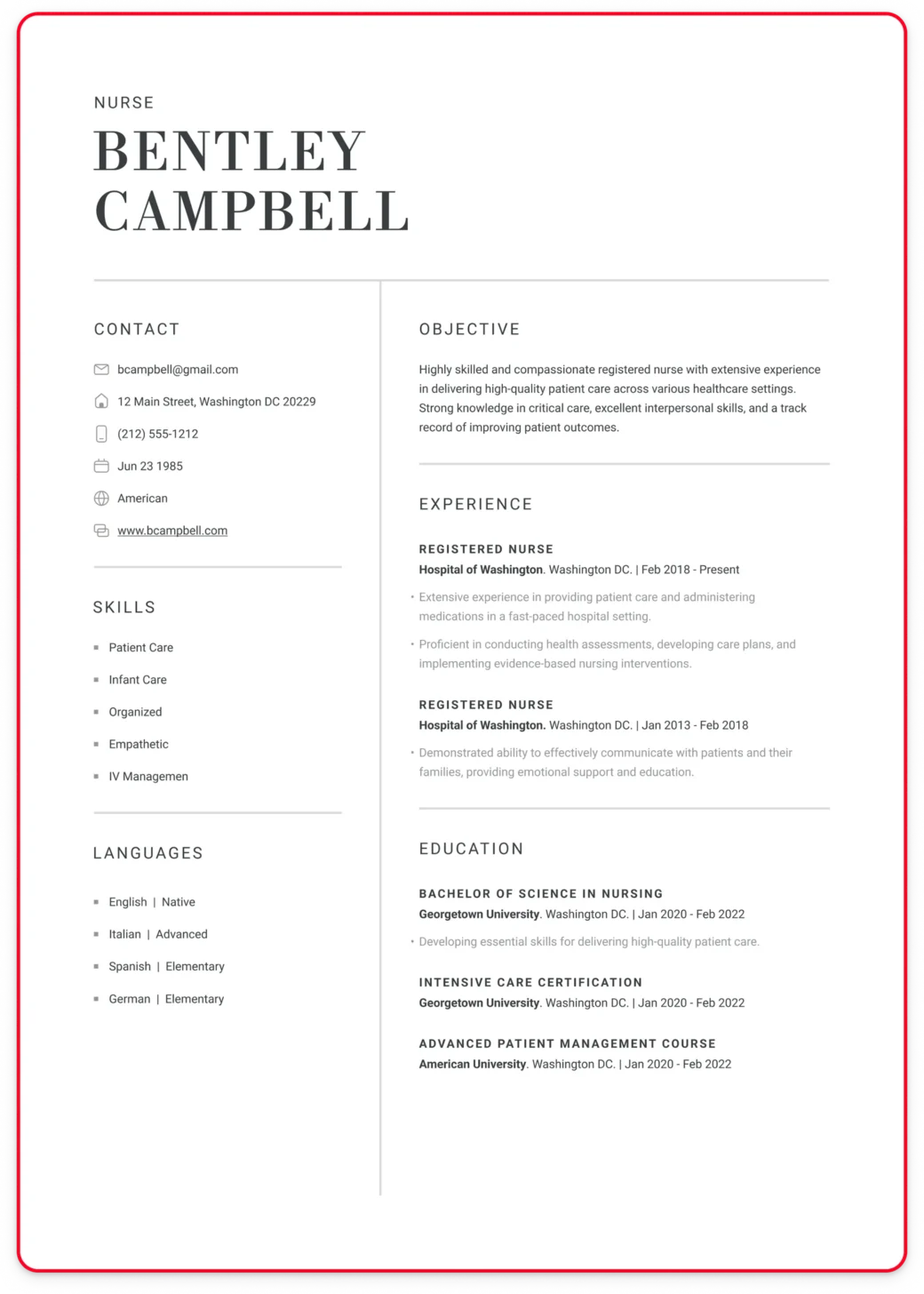
Create and edit your resume online
Generate compelling resumes with our user-friendly tool and secure employment quickly.
Resume examples for 217 jobs

Writing the perfect resume with our help just got easier. Check our resume guides for the job you desire.
Most Popular Resume Examples
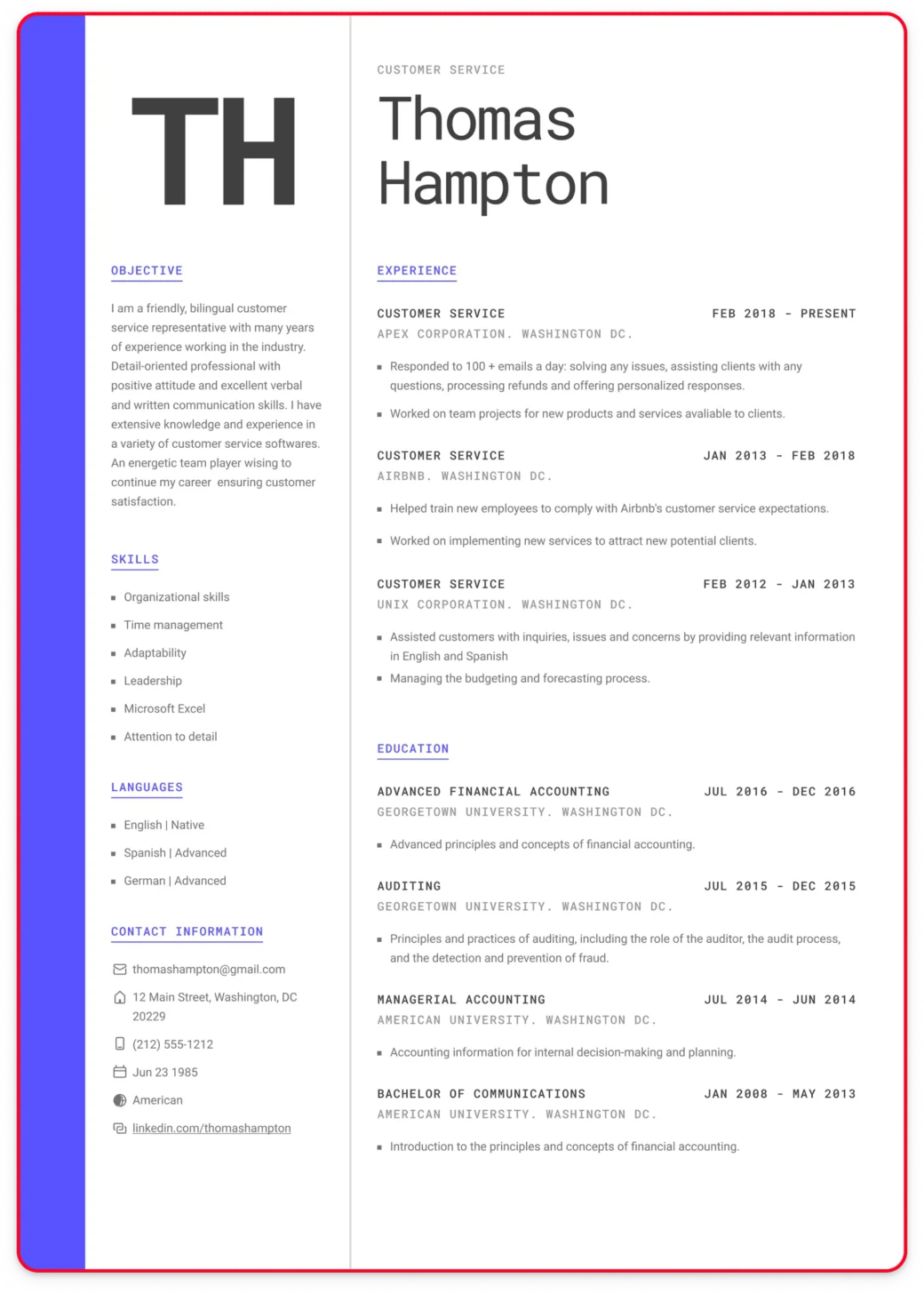
Featured articles
- Free Online Certifications to Add to Your Resume
- Make Shadowing Hours a Part of Your Resume
- How to Decline a Job Offer but Keep the Door Open
Latests articles
- How to Show Your Achievements on a Resume: STAR & CAR Methods
- Improve Your LinkedIn Profile Using ChatGPT
- 5 Tips for Using ChatGPT in Your Interview Prep
- Harness the Power of AI: Master Cover Letter Writing With ChatGPT
- Top Entry-Level Remote Jobs for Beginners in 2024

Dive Into Expert Guides to Enhance your Resume
Make use of expert tips & tricks to to help you build the perfect resume
Adding Your Address on a Resume: Do or Don’t?

Nowadays, resumes may not seem like complex documents to complete, especially when you can use a free online resume builder to structure it in the ideal resume format to nail a job vacancy.
Although these advanced tools definitely help, you may be surprised to learn that the HR personnel likely in charge of hiring you will spend only a few sounds inspecting a resume before moving on to a different candidate.
Therefore, making sure every one of your resume elements is where it needs —and doesn’t need to be— is crucial if you want to get ahead of the competition.
This article includes:
For most jobseekers and their prospective employers, including an address on the resume can be unwise and outdated if done incorrectly.
Everyone communicates online—why waste any space, right?
Still, the address on your resume can reveal a lot about you, so placing it in the appropriate corner of the resume is a smart move. If you are unsure how to write a resume , combining the tips found in this article with our free resume builder will boost your chances of landing that dream gig of yours.
Pros and Cons of Writing Your Address on a Resume
Before email, an address was a synonym for a physical mailbox, where letters, documents, and most bills arrived. Electronic forms of correspondence have supplanted all that. The question now is— is there a benefit of a physical address on a resume?
We’ve crunched the numbers and scoured the internet to find the possible benefits of incorporating an address on your resume:
- Background checks . By providing your address on your resume, you enable the recruiter to check if you are who you claim to be. Checks like these are carried out at the end of the interview process, but having the information from the start shows you have nothing to hide.
- Expected info . Having a traditional postal address on a resume is a standard feature, and managers may want to see it on your application. Some organizations even prefer to respond with a formal letter that has to be signed—and that calls for an address.
- Location . Where you live can affect productivity at the workplace. People commuting long-distance can be more tired and burnt out, potentially making them less professionally attractive for employers. Managers prefer workers who show up on time. Living closer to the office can be a plus factor on your side in this case.
- Application software tracking . Most recruiters use application tracking software to organize their database and perform searches for a potential candidate when a new position opens. A debunked myth is that related software tends to use the address as a keyword, meaning you may miss out on a job due to technicality. There is no proof that the assumption is correct because there is no single and universal application tracking software. Most apps are proprietary, which means developers do not share details.
Now, some practical arguments against providing your address on your resume include:
- Discrimination . Including an address in your resume might lead to localized discrimination. Some employers believe in stereotypes, especially those of a demographic nature, and may exclude you from the hiring process based on the neighborhood you reside in. Studies have shown that, sadly yes, resume bias is a factor in many hiring practices. If you are a member of an ethnic minority, or racial group, or live in a part of a city or locale that you feel is misunderstood and could be discriminated against, perhaps you should forget about including the address.
- Design . The visual look of the resume format is crucial for grabbing attention. Everything needs to be compact and stylish, spaced accordingly, and in line with the file type aesthetics.
- Location . As previously mentioned, if you live far from the office site, the boss may not want to risk hiring an employee who is more likely to be late or unable to make it to work on short notice.
How to Write Your Address on a Resume
When including your address on a resume , be careful to position the relevant info in the appropriate place. By default, free resume templates group the address alongside other contact details.
However, the appropriate resume format is for the address to go into the resume heade r, together with other contact information, like your name and age. Or, if you are worried about potential data misuse, you can only provide the city or region of your residence.
Address on Resume When Relocating
Geography doesn’t limit job mobility, and when relocating to a new city, it’s crucial to update your resume with your current address. The resume envelops your entire work history , and when the companies that employed you in the past are located in another area code, that may confuse future recruiters.
You might also have impressive qualifications , but the employer may think it’s too much of a hustle to wait for your relocation and move on with a local candidate.
If you are still house hunting, mention that you are moving in a cover letter . Alternatively, you can include “relocating” as part of your address, write, say, “Relocating to Portland, Oregon” instead of your home address in a different state.
Examples of How to Add your Address to a Resume
There are several options to consider when handling your address on a resume , depending on what you think is appropriate and can be beneficial in the hiring process.
Providing your full address details shows you have nothing to hide, and that you are a trustworthy person. The address can go in the resume header , located in the sidebar of the document.
[Apollo Rd.111]
[Dallas, TX 75021]
However, if you don’t anticipate physical documents and want to protect your privacy , a good option is to limit information to just the city or wider region. In cases when you may end up not getting the job, you won’t have any linkable address tied to your name.
[Sacramento, California]
When applying for a job in a new city , you should emphasize in the resume that you are in the process of relocating. Also mention the same information in the space where your external contact information is. That way the employer can be sure they can reach you.
[Jane Smith]
[Relocating to Phoenix, AZ]
[000-123-4567] [email: [email protected]]
The Bottom Line on Putting Your Address on a Resume
These days, hiring is almost entirely online, and putting an address on a resume may seem redundant. At the same time, the details can reveal a lot about you , for example, that you are a local and dependable person, which are both qualities that may be important for an employer.
If you choose to provide an address on your resume, position it above your resume headline in a neat and orderly manner. It should never be front and center, just another tiny detail in the bigger picture.
The free resume maker of ResumeGiants is a solid option to help you tailor the perfect summary of your skills and experience.
Related Posts
How to Email a Resume to Get a Job Wondering what to write in an email when sending your resume? Your resume mail to a potential employer has to be just as refined as the resume. Learn how! Updated on March 30, 2023 How to Email a Resume to Get a Job
How to Write a Resume Headline in 2024 with 30+ Examples What makes a resume headline a good one? Find here tips and examples of effective resume headlines that you can use to nail your resume. Updated on January 2, 2024 How to Write a Resume Headline in 2024 with 30+ Examples
Colors on Your Resume: How to Stand Out to Hiring Managers Colors on a resume can help you stand out as a candidate. Find out the dos and don’ts of making your job application colorful. Updated on March 7, 2024 Colors on Your Resume: How to Stand Out to Hiring Managers
- Features for Creative Writers
- Features for Work
- Features for Higher Education
- Features for Teachers
- Features for Non-Native Speakers
- Learn Blog Grammar Guide Community Events FAQ
- Grammar Guide
How to Write an Address: A Complete Guide

Hannah Yang
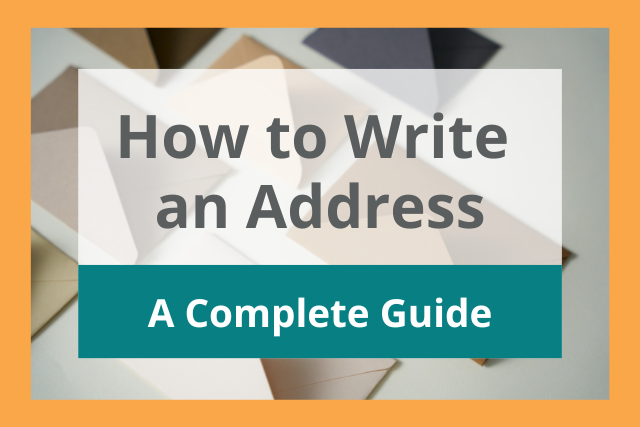
Whenever you mail a letter, you need to write the address correctly. If you format the address incorrectly, your mail might get delivered to the wrong destination.
That’s just one situation in which you’ll need to know how to write an address. You may also need to write your address in the header of a resume, to fill out legal forms, and countless other situations.
If you’re trying to write an address, you’ve come to the right place. This article will give you a complete guide to formatting an address and provide examples of common address formats.
What Is an Address?
What are the address formats for mailing a letter, what are the address formats for specific types of addresses, should you use abbreviations in an address, address examples, conclusion on how to write an address.
An address consists of all the information that a mail carrier needs to identify a location.
Addresses contain some or all of the following pieces of information:
- The recipient’s name
- The organization’s name, if necessary
- Building number
- Street name
- Suite number, apartment number, or P.O. box number, if necessary
- City, town, or village
- State or territory
- Postal code
It’s important to include all the information that the post office needs to identify the correct location, without including any extraneous information. If you add any extraneous lines or words, it will be harder for others to figure out what the actual address is.
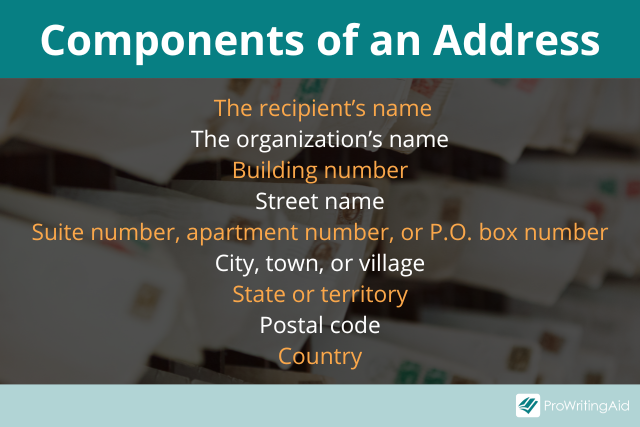
When you mail a letter in the US, you’ll need to include both the recipient’s address and the sender’s address. Let’s look at how to format each one.
Mailing Address Format
Whenever you mail a letter, you need to put the recipient’s address at the center of the envelope. This is where the postal courier will look to figure out where to deliver the letter to.
If you’re writing to a recipient in the US, you should include the following pieces of information, in this order:
- The recipient’s name on the first line. You can choose whether or not to include a title, such as Ms. or Dr.
- The recipient’s building number and street name. Also include a suite number, apartment number, or P.O. box number on the second line, if necessary
- The recipient's city, state, and postal code on the final line
The address should consist of three lines of text, one for each of the bullet points above.
You only need to include a suite or apartment number if you live in a building where multiple individuals or families share the same building number. That way, couriers can figure out which specific apartment to deliver the mail to.
When you write the postal code, you can write out either the five-digit ZIP code (e.g. 98052), or the five-digit ZIP code with the area-specific four-digit suffix (e.g. 98052-1134). Including your full postal code will help couriers deliver your package more quickly.
Return Address Format
The term “return address” refers to the address of the person sending a letter or package. The reason you need to include your own address on any letter or package you send is so the postal service knows where to return the mail if they’re unable to deliver it. You should place your return address on the upper left corner of the envelope.
If you live in the US, you should include the following pieces of information, in this order:
- Your name on the first line. You can choose whether or not to include a title, such as Ms. or Dr.
- Your building number and street name. Also include a suite number, apartment number, or P.O. box number on the second line, if necessary
- Your city, state, and postal code on the final line
Just like with the mailing address, the return address should be three lines of text, one for each of the bullet points above.
The guidelines to follow when writing an address often depends on the specific type of letter you’re writing. For example, if you’re sending an international letter to a country outside of the US, you may need to format your address differently.
Let’s look at some of these specific guidelines.
Business Address Format
When you’re sending mail to a business address, you may need to include some additional information that you wouldn’t include for a personal letter.
That’s because the courier may need to know the company name, as well as the name of the specific person within the company you’re writing to.
Here’s the information you need to include in a business address:
- The recipient’s name. You can precede this name with the word Attention or ATTN, followed by a colon. You can choose whether you want to include any relevant professional titles, such as Ph.D. or Esq.
- The name of the recipient’s company or organization
- The company’s building number and street name
- The company’s floor or suite number, if necessary
- The company’s city, state, and postal code
International Address Format
If you’re mailing a letter outside of the US, you’ll need to adhere to the format of the country you’re sending the letter to. That way, the postal service within that country will know where to go.
In general, these are the pieces of information you should include in an international address:
- The name of the recipient’s house, if their home has a specific name
- The recipient’s building number and street name, if their house does not have a specific name
- The recipient’s city, town, or village
- The recipient’s county
- The recipient’s postal code
- The recipient’s district, if necessary
- The recipient’s country
To be safe, you should always double-check the address format of the specific country you’re mailing to.
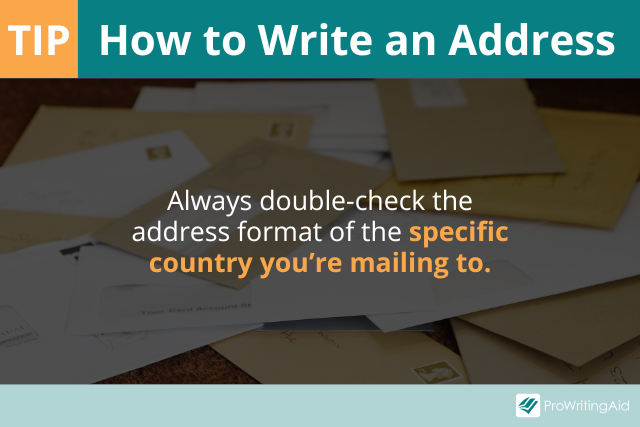
When you write your return address on international mail, you should format it the same way you usually would. In addition, you should include your own country at the bottom of the return address.
Resume Address Format
When you write a professional resume, you should include your address at the top of your resume. You can either include it in your header or add it in the top left corner.
The good news is that you should use the same format for writing an address in a resume that you would use for writing a letter. Include all the same information you would use for a return address.
One-Line Address Format
Sometimes, you may need to write an entire address in a single line of text.
In this case, you should include all the same information that you would include in a multi-line address. The only difference is that you’ll need to replace each line break with a comma when you write an address on one line.
Make sure to include a comma after each of these elements:
- The person’s name
- The street address
- The apartment number or suite
It’s perfectly acceptable to use abbreviations when writing an address—in fact, it’s often expected.
Here are some common abbreviations you should know:
- Apartment: Apt
- Boulevard: Blvd
- Parkway: Pkwy
You should also abbreviate all the US states with a two-letter code. For example, you would write CA for California or DE for Delaware.
To help you understand what a correctly formatted address should look like, we’ve included some examples you can refer to.
US Address Examples
Here’s an example of a domestic residential address in the US:
John Smith 5480 7th Ave San Francisco, CA 94112
Here’s an example of a US address with an apartment number:
Ms. Mary Green 2211 Edgewood St, Apt 2 Boston, MA 02124-1331
One-Line Address Examples
Here’s how you would write each of the above addresses on a single line:
John Smith, 5480 7th Ave, San Francisco, CA 94112 Ms. Mary Green, 2211 Edgewood St, Apt 2, Boston, MA, 02124-1331
Professional Address Examples
If you’re writing a business letter, don’t forget to include the organization’s name. Here’s an example:
Attn: Rachel Long, CEO The Greatest Writers’ Organization 780 English Avenue, Floor 8 Seattle, WA 90199
International Address Examples
Here’s an example of an address in Canada:
Jacob White 423 Second Street NE Montreal, QC H3Z 2Y7 Canada
(In this case, Montreal is the city, QC is the province, and H3Z 2Y7 is the postal code.)
Here’s an example of an address in Great Britain:
Harry Brown 87 Blackstone Street London EC1Y 8SY England
(In this case, London is the city, and EC17 8SY is the postal code.)
There you have it—a complete guide to writing an address correctly! Here’s a quick recap:
- An address should include everything a mail carrier needs to identify the recipient’s location
- It’s expected that you’ll use standard abbreviations, such as St for Street
- The guidelines may be different for international addresses, so always double-check each country’s guidelines
Lastly, make sure you write your address in clear and legible handwriting, so your mail can be delivered efficiently.

Be confident about grammar
Check every email, essay, or story for grammar mistakes. Fix them before you press send.
Hannah Yang is a speculative fiction writer who writes about all things strange and surreal. Her work has appeared in Analog Science Fiction, Apex Magazine, The Dark, and elsewhere, and two of her stories have been finalists for the Locus Award. Her favorite hobbies include watercolor painting, playing guitar, and rock climbing. You can follow her work on hannahyang.com, or subscribe to her newsletter for publication updates.
Get started with ProWritingAid
Drop us a line or let's stay in touch via :

How to Write a Cover Letter That Will Get You a Job
I ’ve read thousands, maybe tens of thousands, of cover letters in my career. If you’re thinking that sounds like really boring reading, you’re right. What I can tell you from enduring that experience is that most cover letters are terrible — and not only that, but squandered opportunities. When a cover letter is done well, it can significantly increase your chances of getting an interview, but the vast majority fail that test.
So let’s talk about how to do cover letters right.
First, understand the point of a cover letter.
The whole idea of a cover letter is that it can help the employer see you as more than just your résumé. Managers generally aren’t hiring based solely on your work history; your experience is crucial, yes, but they’re also looking for someone who will be easy to work with, shows good judgment, communicates well, possesses strong critical thinking skills and a drive to get things done, complements their current team, and all the other things you yourself probably want from your co-workers. It’s tough to learn much about those things from job history alone, and that’s where your cover letter comes in.
Because of that …
Whatever you do, don’t just summarize your résumé.
The No. 1 mistake people make with cover letters is that they simply use them to summarize their résumé. This makes no sense — hiring managers don’t need a summary of your résumé! It’s on the very next page! They’re about to see it as soon as they scroll down. And if you think about it, your entire application is only a few pages (in most cases, a one- or two-page résumé and a one-page cover letter) — why would you squander one of those pages by repeating the content of the others? And yet, probably 95 percent of the cover letters I see don’t add anything new beyond the résumé itself (and that’s a conservative estimate).
Instead, your cover letter should go beyond your work history to talk about things that make you especially well-suited for the job. For example, if you’re applying for an assistant job that requires being highly organized and you neurotically track your household finances in a detailed, color-coded spreadsheet, most hiring managers would love to know that because it says something about the kind of attention to detail you’d bring to the job. That’s not something you could put on your résumé, but it can go in your cover letter.
Or maybe your last boss told you that you were the most accurate data processor she’d ever seen, or came to rely on you as her go-to person whenever a lightning-fast rewrite was needed. Maybe your co-workers called you “the client whisperer” because of your skill in calming upset clients. Maybe you’re regularly sought out by more senior staff to help problem-solve, or you find immense satisfaction in bringing order to chaos. Those sorts of details illustrate what you bring to the job in a different way than your résumé does, and they belong in your cover letter.
If you’re still stumped, pretend you’re writing an email to a friend about why you’d be great at the job. You probably wouldn’t do that by stiffly reciting your work history, right? You’d talk about what you’re good at and how you’d approach the work. That’s what you want here.
You don’t need a creative opening line.
If you think you need to open the letter with something creative or catchy, I am here to tell you that you don’t. Just be simple and straightforward:
• “I’m writing to apply for your X position.”
• “I’d love to be considered for your X position.”
• “I’m interested in your X position because …”
• “I’m excited to apply for your X position.”
That’s it! Straightforward is fine — better, even, if the alternative is sounding like an aggressive salesperson.
Show, don’t tell.
A lot of cover letters assert that the person who wrote it would excel at the job or announce that the applicant is a skillful engineer or a great communicator or all sorts of other subjective superlatives. That’s wasted space — the hiring manager has no reason to believe it, and so many candidates claim those things about themselves that most managers ignore that sort of self-assessment entirely. So instead of simply declaring that you’re great at X (whatever X is), your letter should demonstrate that. And the way you do that is by describing accomplishments and experiences that illustrate it.
Here’s a concrete example taken from one extraordinarily effective cover-letter makeover that I saw. The candidate had originally written, “I offer exceptional attention to detail, highly developed communication skills, and a talent for managing complex projects with a demonstrated ability to prioritize and multitask.” That’s pretty boring and not especially convincing, right? (This is also exactly how most people’s cover letters read.)
In her revised version, she wrote this instead:
“In addition to being flexible and responsive, I’m also a fanatic for details — particularly when it comes to presentation. One of my recent projects involved coordinating a 200-page grant proposal: I proofed and edited the narratives provided by the division head, formatted spreadsheets, and generally made sure that every line was letter-perfect and that the entire finished product conformed to the specific guidelines of the RFP. (The result? A five-year, $1.5 million grant award.) I believe in applying this same level of attention to detail to tasks as visible as prepping the materials for a top-level meeting and as mundane as making sure the copier never runs out of paper.”
That second version is so much more compelling and interesting — and makes me believe that she really is great with details.
If there’s anything unusual or confusing about your candidacy, address it in the letter.
Your cover letter is your chance to provide context for things that otherwise might seem confusing or less than ideal to a hiring manager. For example, if you’re overqualified for the position but are excited about it anyway, or if you’re a bit underqualified but have reason to think you could excel at the job, address that up front. Or if your background is in a different field but you’re actively working to move into this one, say so, talk about why, and explain how your experience will translate. Or if you’re applying for a job across the country from where you live because you’re hoping to relocate to be closer to your family, let them know that.
If you don’t provide that kind of context, it’s too easy for a hiring manager to decide you’re the wrong fit or applying to everything you see or don’t understand the job description and put you in the “no” pile. A cover letter gives you a chance to say, “No, wait — here’s why this could be a good match.”
Keep the tone warm and conversational.
While there are some industries that prize formal-sounding cover letters — like law — in most fields, yours will stand out if it’s warm and conversational. Aim for the tone you’d use if you were writing to a co-worker whom you liked a lot but didn’t know especially well. It’s okay to show some personality or even use humor; as long as you don’t go overboard, your letter will be stronger for it.
Don’t use a form letter.
You don’t need to write every cover letter completely from scratch, but if you’re not customizing it to each job, you’re doing it wrong. Form letters tend to read like form letters, and they waste the chance to speak to the specifics of what this employer is looking for and what it will take to thrive in this particular job.
If you’re applying for a lot of similar jobs, of course you’ll end up reusing language from one letter to the next. But you shouldn’t have a single cover letter that you wrote once and then use every time you apply; whatever you send should sound like you wrote it with the nuances of this one job in mind.
A good litmus test is this: Could you imagine other applicants for this job sending in the same letter? If so, that’s a sign that you haven’t made it individualized enough to you and are probably leaning too heavily on reciting your work history.
No, you don’t need to hunt down the hiring manager’s name.
If you read much job-search advice, at some point you’ll come across the idea that you need to do Woodward and Bernstein–level research to hunt down the hiring manager’s name in order to open your letter with “Dear Matilda Jones.” You don’t need to do this; no reasonable hiring manager will care. If the name is easily available, by all means, feel free to use it, but otherwise “Dear Hiring Manager” is absolutely fine. Take the hour you just freed up and do something more enjoyable with it.
Keep it under one page.
If your cover letters are longer than a page, you’re writing too much, and you risk annoying hiring managers who are likely sifting through hundreds of applications and don’t have time to read lengthy tomes. On the other hand, if you only write one paragraph, it’s unlikely that you’re making a compelling case for yourself as a candidate — not impossible, but unlikely. For most people, something close to a page is about right.
Don’t agonize over the small details.
What matters most about your cover letter is its content. You should of course ensure that it’s well-written and thoroughly proofread, but many job seekers agonize over elements of the letter that really don’t matter. I get tons of questions from job seekers about whether they should attach their cover letter or put it in the body of the email (answer: No one cares, but attaching it makes it easier to share and will preserve your formatting), or what to name the file (again, no one really cares as long as it’s reasonably professional, but when people are dealing with hundreds of files named “resume,” it’s courteous to name it with your full name).
Approaching your cover letter like this can make a huge difference in your job search. It can be the thing that moves your application from the “maybe” pile (or even the “no” pile) to the “yes” pile. Of course, writing cover letters like this will take more time than sending out the same templated letter summarizing your résumé — but 10 personalized, compelling cover letters are likely to get you more interview invitations than 50 generic ones will.
- ‘I Had a Great Job Interview — Why Haven’t I Heard Back?’
- How to Answer ‘Tell Me About Yourself’ in a Job Interview

TechRepublic
Project management.

10 Best Free Project Management Software & Tools for 2024
Free project management software provides flexibility for managing projects without paying a cent. Our list includes free and freemium products that can manage most projects or introduce you to your next paid project management software.

12 Best Project Management Software for Mac Users in 2024
This is a comprehensive list of the best project management software for Mac. Use this guide to compare and choose the best solutions for your business.

Asana vs Monday 2024: The Ultimate Project Management Showdown
Discover which project management tool leads in 2024. Compare Asana vs Monday on their features, usability, and more for the best fit, thanks to our expert research and guidance. Make your decision today.

Trello vs. Jira Showdown: Who Wins in 2024?
Discover the key differences between Trello and Jira. Find out which project management tool tops your needs with our expertly researched guide.

8 Best Flowchart Software Tools for 2024
This is a comprehensive list of the best flowchart software, covering features, pricing and more. Use this guide to determine the most suitable software for you.
Latest Articles

TechRepublic Premium Editorial Calendar: Policies, Checklists, Hiring Kits and Glossaries for Download
TechRepublic Premium content helps you solve your toughest IT issues and jump-start your career or next project.

7 Best Open Source Kanban Boards for 2024
Check out 7 of the best open-source kanban boards, comparing their features, integrations, strengths, weaknesses and unique characteristics.

Microsoft Project vs. Smartsheet (2024): Which Tool Is Better?
Is Microsoft Project similar to Smartsheet? Use our guide to compare the main differences in features and pricing between Microsoft Project and Smartsheet.

Teamwork.com vs monday.com (2024): Which Tool Is Better?
What are the main differences between Teamwork.com and monday.com? Use our guide to compare pricing and features.

Asana vs. ClickUp (2024): Which Tool Should You Choose?
Which is better, Asana or ClickUp? Read our comparison guide to decide which one fits you best in terms of pricing, pros, cons and more.

Celoxis: Project Management Software Is Changing Due to Complexity and New Ways of Working
More remote work and a focus on resource planning are two trends driving changes in project management software in APAC and around the globe. Celoxis’ Ratnakar Gore explains how PM vendors are responding to fast-paced change.

The 10 Best Trello Alternatives for 2024
Discover 10 of the top alternatives to Trello and see how they approach key features alongside their pros, cons, cost and top integrations.

Asana vs Jira (2024): Which Tool Should You Choose?
See how Asana and Jira compare across features, pricing and usability to determine the better project management tool for your team.

Trello vs. Slack (2024): What Are the Main Differences?
What are the differences between Trello and Slack? Can they work together? Use our guide to compare features, pricing and more.

Top 8 Software Development Project Management Tools for 2024
Discover the best software development project management tools for your team. Our guide covers pricing and standout features to help you choose.

Top 5 To-Do List Apps for 2024 (Free & Paid)
Looking for a good to-do list app that will help you keep track of tasks? Read our guide to review our recommended apps for 2024.

6 Best Microsoft Project Alternatives & Competitors for 2024
Looking for another tool to use besides Microsoft Project? Use our buyer's guide to find the best free and paid Microsoft Project alternatives for 2024.

Rally vs Jira (2024): What Are the Main Differences?
Compare Rally and Jira across cost, features, strengths and weaknesses to determine which platform is right for your agile project management needs.

Zoho Projects vs Wrike (2024): Which Tool Should You Choose?
What are the pros and cons of using Zoho Projects or Wrike? Use our guide to compare tools and decide which tool your business should use.

Trello vs Todoist (2024): Which Tool Is Better for Your Team?
When it comes to project management solutions, Trello and Todoist rise to the top. Check out this review comparing the stand-out features of Trello and Todoist.
Create a TechRepublic Account
Get the web's best business technology news, tutorials, reviews, trends, and analysis—in your inbox. Let's start with the basics.
* - indicates required fields
Sign in to TechRepublic
Lost your password? Request a new password
Reset Password
Please enter your email adress. You will receive an email message with instructions on how to reset your password.
Check your email for a password reset link. If you didn't receive an email don't forgot to check your spam folder, otherwise contact support .
Welcome. Tell us a little bit about you.
This will help us provide you with customized content.
Want to receive more TechRepublic news?
You're all set.
Thanks for signing up! Keep an eye out for a confirmation email from our team. To ensure any newsletters you subscribed to hit your inbox, make sure to add [email protected] to your contacts list.

IMAGES
VIDEO
COMMENTS
In short, the address on a resume should go right in the resume header, along with your name and other contact details. Have a look at the examples below. Address on a Resume—Example. In the example above, the address is included along with the other personal information in the sidebar.
You can include your address at the top of your resume with your other contact details. Usually, the ideal method is to put your address after your mobile number and email address. When including your address in your resume, ensure you check for any spelling or typographical errors. Align your address the same way you align the rest of your ...
Online privacy. Online privacy is a big deal and should be considered whenever you post your name and address online. Using your full home address on your resume could open you up to identity theft, scammers, unwanted marketing, or spam, especially if your resume is posted to public forums. Safety concerns.
As featured in *. You should put your address on your resume only if you think it will improve your chances of being hired, but usually it's not necessary. Traditionally, including your address when you write your resume was standard practice because employers would reach out to you via physical mail. Today, most (if not all) jobs handle ...
To include an address on your resume, place it in the header or contact information section at the top, using a consistent format. Consider privacy concerns and whether to include only your city and state. Ensure the address aligns with your resume's overall design and if you think it's relevant, use an address local to the company (for example ...
The only time employers absolutely need your physical address is during the final stages of the offer process. This is to complete the necessary paperwork to ensure you are legally in their systems so you can move forward. It is acceptable to keep your address private until this stage. Related: 6 Universal Rules for Resume Writing.
When putting your address on your resume include either your full mailing address (street address, city, state, and zip code), or just your city and state. It's a good idea to write your state name in full if the postal abbreviation is easily confused with another, like MI, MS, and MO. Here's how the two variations look.
For that reason, consider skipping your address in favor of more important information. It might not look like much, but it allows you to add a few more skills, another degree or certification, publication, volunteer experience, or even a hobby. #6. Location is Not Relevant to the Job.
Related: The Essential Parts of a Resume, Explained. Email Address. If you're still using an old AOL or Hotmail address to manage your email, it's time for an upgrade. Create a new, professional-looking email address for all your job-search activities with a modern provider like Gmail.
Phone Number on a Resume. It is best to include your cell phone number (if you also happen to still have a landline). How to properly write a phone number varies by country. Just remember, if you are looking for a job in another country, include your country's dialing code with your phone number: +1 (718) 555-1212.
1. Keep it as short as possible. Include only your street address, city, state abbreviation, and zip code. The longer you format your address, the more likely it will spill onto a second line. So abbreviate whenever you can (e.g., "North" as "N.", "Road" as "Rd.", and "Massachusetts" as "MA"). You can also opt to leave ...
In this regard, you might want to exclude your city and state from the address so that the hiring manager can know you are open to relocation. Alternatively, you can simply write 'open to relocation' on your address. For example: Xavier Polch. Open to Relocate Nationwide|555-727-8128|[email protected].
Write your full name in a bold font at the top of your resume. Make sure it's legible, in a simple, professional typeface to help make a positive first impression on the hiring manager. Include your phone number after your name. Write your email address under your name after listing your phone number. Include the city and state where you live ...
If you're applying to jobs outside of the U.S. and Canada, your full address is often a requirement, Liou says. Some federal government jobs will also require a mailing address on your resume (the government is one of the few entities that still sends snail mail to applicants). And for some jobs—a local delivery job, a community advocate ...
You can write your full address on your resume if necessary. Your full address includes your house number, street name, province, city, and postal code. This is the traditional and most comprehensive way of writing your address on your resume. Example: 25 Peter Street. Brooks, Alberta.
Email address; Full Name on Resume. Firstly, do not write "Resume" or "CV" as the heading of your resume. Use your full name. And ensure your name is consistent across all job application documents. For example, if you are writing your middle name on your resume, ensure it's the same everywhere. Similarly, if you are not using a ...
Examples of including an address on a resume You may aim to write your address at the top of your resume to help attract the hiring manager's attention. If your job application requires a cover letter, try to write the address at the top in single-spaced separate lines. Here are some examples of addresses depending on your confidentiality ...
Tap enter once (single spaced) and change the font to 10 or 12-point Times New Roman or Courier. You may also enter a horizontal line here to separate your name from the information in Step 3. Type your address, using numbers for the street number and for your apartment number (if necessary).
Related: Resume samples and templates to inspire your next application 2. Include your name and contact information Your resume should begin with your name and contact information, including your email address and phone number. You have a choice about whether or not to include your mailing address. Your name should be highly visible at the top ...
When including your address on a resume, be careful to position the relevant info in the appropriate place. By default, free resume templates group the address alongside other contact details. However, the appropriate resume format is for the address to go into the resume heade r, together with other contact information, like your name and age.
The recipient's building number and street name. Also include a suite number, apartment number, or P.O. box number on the second line, if necessary. The recipient's city, state, and postal code on the final line. The address should consist of three lines of text, one for each of the bullet points above.
Knowing how to write an address can sometimes get confusing. Stop second-guessing and check out these rules for the correct address format. ... How to Write an Address on a Resume. As you can see from most resume examples, you should include your address at the top of the resume. This is part of your contact information that a potential ...
Tap on the Me icon next to the search bar at the top. On the slide menu, tap View Profile under your name. Tap the gear icon in the top right corner. Select the privacy tab, and tap on Edit your public profile. Edit your custom URL. To share the link, tap on the URL and hold your finger for a moment. This is it.
How to Write a Resume Write the perfect resume and get more interviews. ... Include your name, phone number, email address, and location. Resume Summary: The resume summary provides a concise snapshot of your qualifications. It should touch upon your unique skills, expertise, and accomplishments. The goal is to attract the reader's interest.
I get tons of questions from job seekers about whether they should attach their cover letter or put it in the body of the email (answer: No one cares, but attaching it makes it easier to share and ...
Donald J. Trump, speaking from the gilded lobby of his Midtown Manhattan tower, excoriated prosecutors and the judge in his criminal case and ran through a litany of false statements. President ...
Project Management Project Management Celoxis: Project Management Software Is Changing Due to Complexity and New Ways of Working . More remote work and a focus on resource planning are two trends ...